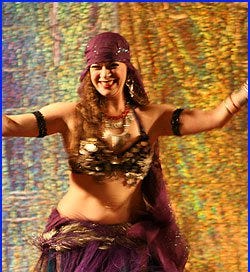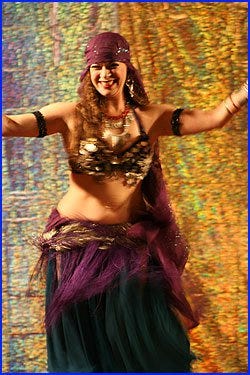American Cabaret in a Culturally Appropriate World
How do you approach the vintage vibes of American Cabaret, knowing what we do now about cultural appropriating? Let's explore!
cul·tur·al ap·pro·pri·a·tion
noun
1. the unacknowledged or inappropriate adoption of the customs, practices, ideas, etc. of one people or society by members of another and typically more dominant people or society.
When I first leaned into the gorgeous world that is “belly dance”, I studied American Cabaret style. It’s a fantastic and fun, bright colorful swishy dance, one that can and should be treated with some caution. Let me explain.
American Cabaret, or Am Cab for short, is a mish-mash of movement and styling that developed in the early 1960’s, reaching its peak in the 70’s and early 80’s. The belly dance aesthetic connected easily to the hippie movement as it embraced different ethnicities of dress and culture. Renaissance fairs bloomed with nods to the Silk Road as belly dance shows became a normal part of the entertainment lineup. Hollywood used the archetype of the “exotic” belly dancer in film and tv such as James Bond, Star Trek, and I Dream of Genie. Suddenly, the general public wanted to see belly dance, and there was a need to get more dancers into clubs – quickly.
Belly dance wasn’t as accessible as it is today. Dancers had to learn from each other, sometimes on the job. They watched old Egyptian old movies (if you were lucky enough to get your hands on any). The movies might be from anywhere. There was no internet to research or connect. There weren’t translators easily available.
Costuming was also challenging. Good luck if you couldn’t sew; you had to make most of your own costumes and accessories! All manner of textiles were used: Persian lace, striped full floor length circle skirts slit all the way up, chiffon flounces on the hip to accentuate, coin bra and belt sets, and more glass hand beaded fringe than you could shake a stick at. The emphasis was to put together what looked good on stage, without regard to mixing of elements and cultures. It was gorgeous indeed but was it appropriative?
Am Cab styling created a look that was recognizable not just in the costumes, but also the movement. Lacking teachers from points of origin in Southwest Asia and North Africa (SWANA), the Am Cab dancers just whipped it together from what they saw and tried to figure things out on the fly, adding what they knew along the way. Without translations or growing up with the music, American dancers simply heard the music differently. Modern elements began to sneak in.
Comparing American Cabaret stylings to Egyptian dancers in the same time period, Am Cab posture was more thigh driven, the driving of a shimmy lower and looser, a hip drop became a lean back, arms and torso used so much more. Finger cymbals were a must have and stayed on throughout the performance. Floor work, belly rolls, coin flipping, and flashy tricks became popular as the Am Cab dancers needed to entertain an American audience that was not as familiar with nuances in music and emotional presentation. Props were added for long shows to break up a dancers’ set, often up to seven parts and 30-45 minutes long. While dancing with a veil was present in the countries of origin (famously used to lift a dancers’ arm carriage, then discarded quickly), it was taken to new heights and levels by the dancers here in the United States, who had no restrictions besides their imaginations.
Am Cab paints a lovely picture. But is that picture harmful? By ignoring the rules of the cultures of origin of the dance, is Am Cab even the same dance? And with the deep Orientalist bent inherent in the costumes and styling, how can we in good conscience continue performing it?
The answer is surprisingly simple. We have, as dancers, a moral obligation to preserve and protect the dance. Use your platform of performance wisely. The time for Am Cab is when you are not at all in danger of presenting the style as “authentic”, as in, from points of origin. So how do we do this?
Learn more. Apply what you’ve learned. Take as many classes from dancers of origin as you can. Listen to as much music as possible and KNOW THE LYRICS of what you’re performing to. Know what costume pieces or fabrics are from which countries.
Know your audience. If you are asked to perform solo for a general public venture where you may not have a chance to speak to anyone, please take the time to perform a dance style that is from a point of origin. Yes, Am Cab was designed to be flashy and entertaining, but if there is any chance the general public is going to misconstrue your presentation as “real”, you risk disrespecting the cultures of where this dance began. If you are asked to perform for a school, this is not the time to throw on your hip floofs. We can, however, present Am Cab ethically. Performing at a belly dance festival, show, or competition where there will be other dancers? Performing somewhere you can have an educational write up or even just a short announcement stating that the style is purely fantasy? Go for it, it’s your sparkle time!
Observe and think about your presentation. Examine your dance as it applies to Orientalism. If you’re unsure, ask for help! Sometimes outside eyes can see what we were taught to ignore. For example, there is a move in veil work where the dancer wraps the veil around the head neck and shoulders, leaving only the eyes visible. Another example is entering with the veil tucked into the costume, changing to unwrapping the fabric when it’s time for the veil dance. Both of these can be seen as fairly problematic- the head wrap being roughly looking like a niqab (headdress) but with the body exposed. Yikes. Unwrapping a veil fully around the costume can be interpreted to look like stripping. You may still choose to do these moves. I don’t do the first anymore; I leave the veil loose around my face to frame but not look so much like the headdress. I still do the second, but generally tuck the veil low into my skirt only so it’s not so stark a body reveal. I figure I get bonus points for adding hip floofs!
So the short of it is, American Cabaret is a valid style of belly dance. AND. It should be seen through the same lens as more modern fusion. Be acutely aware of what you are doing, how you are presenting it, and who you are presenting to. Place the crown of authenticity squarely where it belongs, on dances of origin. And then let your fantastic sparkly self play!
About the Author:
Maia Alexandra is an artist based out of Buffalo, NY. She loves the vintage vibes and chocolate chip cookies.







Love this perspective! I love the attitude of centering our shows around our audience and being well researched about our presentation